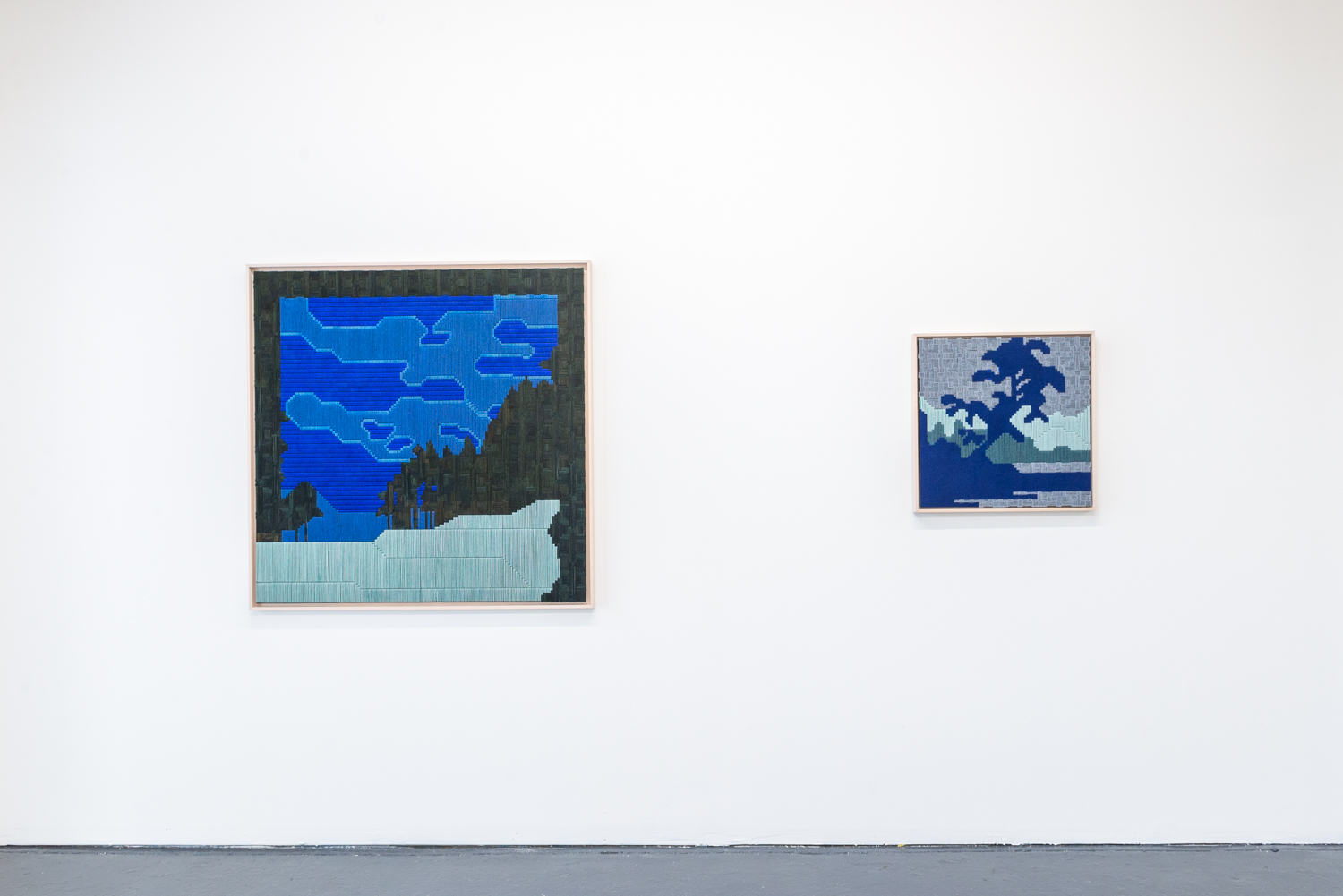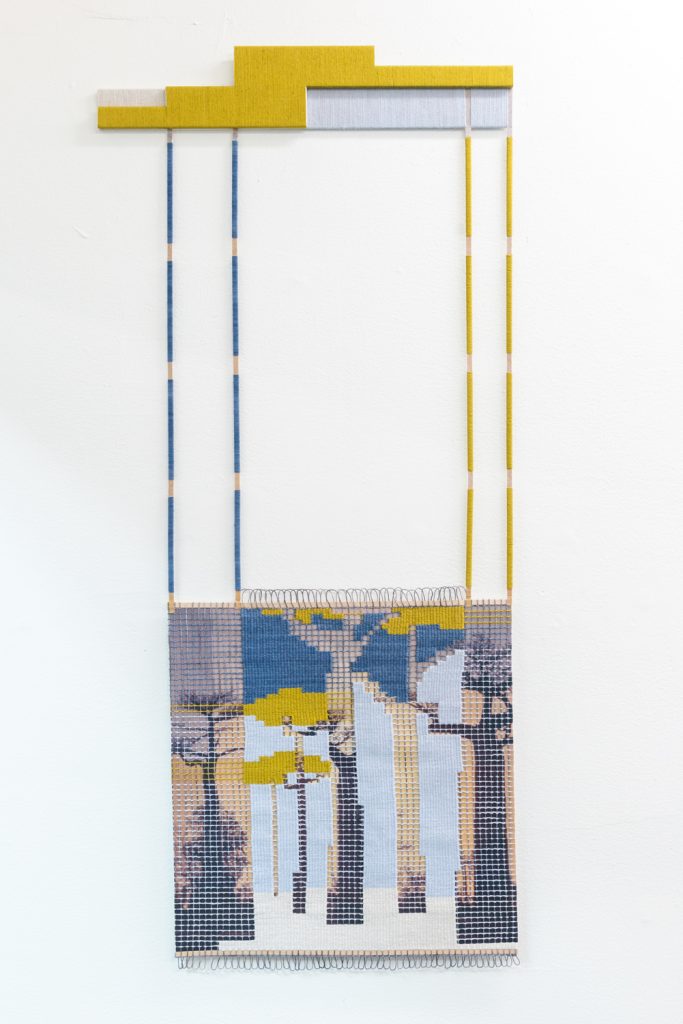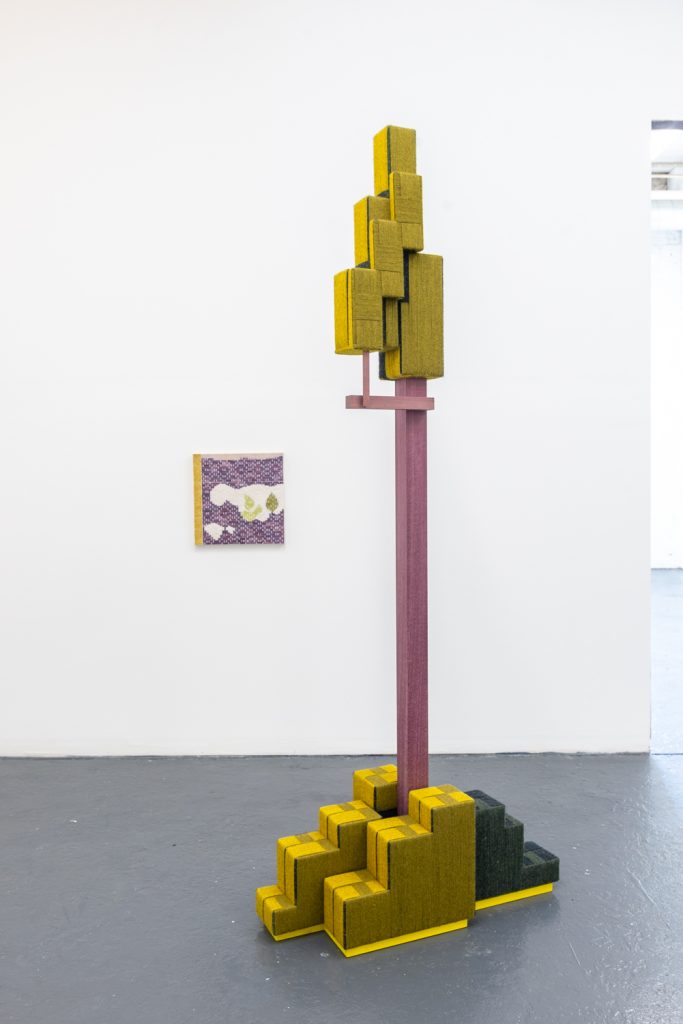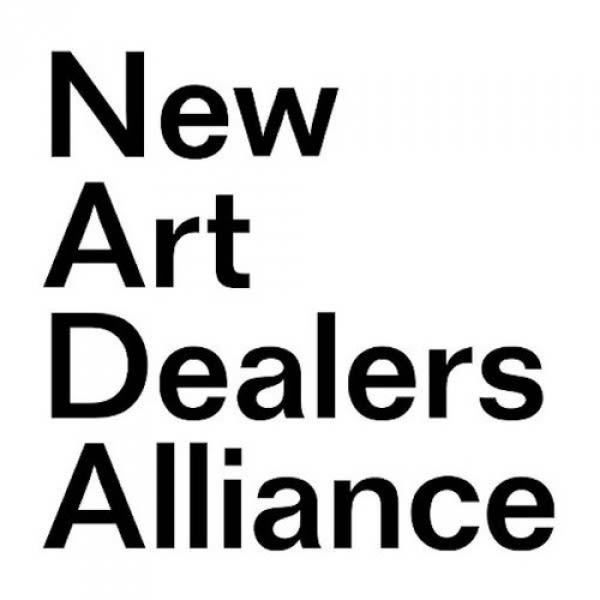How can physical space have such an underlying influence on the way we feel? How can our surroundings inform our sense of belonging? The artist Azadeh Gholizadeh explores these questions in her solo exhibition, Dawn to Dusk, at Goldfinch from February 27th to April 9th, 2022. By recalling memories of Iran and her present experience living in Chicago, Gholizadeh uses geometric abstraction to depict landscapes in tapestries while probing how identities are inextricably tied to the environment.
After growing up and studying in Iran, Azadeh Gholizadeh left in 2010 and moved to Chicago to begin her artistic practice. Prior to her move, she studied Architecture and Urbanism and would visit, analyze, and admire various architecture and landscapes around Iran. Sometimes, she would venture to her favorite places like the Persian garden, the Fin Gardin in Kashan. And like many people, she would use a camera to capture a photo of an interesting tile, the sunlight hitting the leaves of a tree, or dewdrops on a lamb’s ear. Eventually, these small habits and experiences would inspire her methodical process and artwork about spaces and belonging.

Walking into the exhibition at Goldfinch, the white walls are covered with tapestries with one sculptural work, The tree, located in the far left corner. Most of the tapestries, such as Behind and the series Twelve12views, are constructed in a strict square or rectangular format. Other works, such as With the Giants II, Blue in Green, By the Campfire, Blue and Blue Hour have a square format but deviate slightly by incorporating detailed accents. The square tapestry background of By The Campfire, for instance, has a cross tessellation pattern made of cobalt blue merino wool. The cobalt contrasts with a Prussian blue wool that is speckled with bits of gray and white and threaded horizontally and intermixed with the smooth and flat texture of geometric-shaped felt. At the bottom of the piece, loose strands of plum-colored yarn hang delicately. Behind the tapestry is a bright yellow backboard made of wood. The yellow peeks out at the base and has a glowing effect on all sides, causing the tapestry to resemble the hazy experience of seeing the outline of a tree canopy at sundown or sunrise.

The tapestry, With the Giants II, strays even more into experimentation by incorporating a structure that indulges the use of negative space. While the imagery in the tapestry is a clearer depiction of trees, the abstraction is articulated in the tapestry’s construction. The square tapestry hangs from a combination of rectangular blocks and four long strands — two blue strands on the left and two yellow strands on the right. Around the border of the tapestry is an intricate accent of a single purple thread looping around the edges. The level of detail draws the viewer into an endless exploration of texture and structure. The negative space suggests a symbolic reading of the blue and yellow strands as the elements of rain and rays of sunlight that move downwards hitting the earth. The negative space also evokes a sense of architecture, like peering out a window of a building — an interpretation supported by the exhibition text, which states that the works are “inspired by the Iranian artist’s experience of looking out through windows at landscapes that spur memories of her past life in Tehran combined with observations derived from her present locale.”1
Stylistically, Gholizadeh’s work sits somewhere between the geometric rigor of pioneering hand makers like Annie Albers or Trude Guermonprez and the unweaving of contemporary craft like the fiber artist Lenore Tawney. Gholizadeh strikes a balance between the meticulous structuring and layering of abstract patterns and fibers by incorporating playful accents based on impulse, such as the small looping of a thread on the edges of a tapestry or creating a yellow glow with the integration of a wooden backboard. But, what all of these artists have in common is that their works favor structural and space-defining qualities over the medium’s pictorial capacities.
Gholizadeh lightly treds with pictorial representation through landscape. In the exhibition text, the artist explains her use of “elements from nature such as clouds, mountain peaks, forests, and leaves because they give [her] comfort and a sense of refuge.”2 This is evident in the geometric blue outline of a tree in the tapestry Blue and even the sculptural The tree. However, the end result of the tapestries is not to accurately represent the imagery. The work is abstract and blurry for reasons related to the memory of landscapes as well as the quality of using fiber itself.

Fiber, as a material, is acutely attuned to the conceptual pursuits of Gholizadeh. Fiber can be a personal and nostalgic material. Like the comfort and refuge Gholizadeh expresses she felt in experiencing nature, fiber is often associated with these feelings. From a very young age, we begin to make distinctions between fiber materials and create preferences based on texture and thickness. As the scholar Julia Bryan-Wilson writes, “Before children reach school age, they know which fabrics itch, which are smooth, which are warm.”3 Very quickly, we become familiar with the utility aspects of fiber and at the same time develop emotional attachments to certain qualities. We may keep an old band t-shirt, a hand-knitted scarf, or a quilted blanket from a grandmother for years until it disintegrates. Feelings related to comfort and nostalgia are evident in Gholizadeh’s fiber tapestries.
Contemporary art has explored fiber and its connection to nostalgic memory as well as its handmade associations to counter what art historian Maria Elena Buszek calls the “tyrannical pressure of technology.” In the introduction of Extra/Ordinary, Buszek writes, “In today’s information age the sensuous, tactile ‘information’ of craft media speaks…of a direct connection to humanity that is perhaps endangered or at the very least being rapidly reconfigured in our technologically saturated, twenty-first-century lives — thus, demonstrating the extraordinary potential of these seemingly ordinary media and processes.”4 One effect of Gholizadeh’s use of fiber is that it feels nostalgic, but it’s also handmade and feels connected to humanity as well as nature, which is evident in the landscape references.
Because Gholizadeh uses fiber and source imagery based on memories of landscape, the tapestries evoke nostalgia, but it is important to note that this nostalgia is not rooted in a longing for the past or escape. Rather, Gholizadeh’s nostalgia is oriented toward the future. The term “nostalgia” was first used by the Swiss physician Johannes Hofer in 1688 in his medical dissertation to refer to the medical condition “homesickness”, which was “characterized by an incapacitating longing for one’s motherland.”5 While Gholizadeh may have a longing, her work is aimed at exploring how a place comes to feel like home or like a place of belonging. Is it the amount of time we spend in a place? Is it the attention we give to small details like the hues of a landscape? Or the materials to form buildings?
In my conversation with Gholizadeh, she talked about growing up and driving for hours every weekend to the Caspian Sea to visit extended family. She remembers the hues of the landscape looking out the window and the smell of the sea. And while these memories of home are important to her work, her focus does not indulge in a longing for the past. Rather, Gholizadeh uses these memories to contemplate her presence in Chicago. She highlights the future-oriented effects of nostalgia such as promoting the types of affective states that mobilize the self for action and an appreciation for both the past and hopefulness for the future — a sort of looking forward by looking back.
* * *
Works Cited
- Exhibition Text, Dawn to Dusk, Goldfinch Gallery, Chicago, IL.
- Exhibition Text, Dawn to Dusk, Goldfinch Gallery, Chicago, IL.
- Julia Bryan-Wilson, “Introduction: Textile Politics,” Fray: Art + Textile and Politics” (Chicago and London: University of Chicago Press, 2017).
- Maria Elena Buszek, “Introduction,” Extra/Ordinary: Craft and Contemporary Art (Durham and London: Duke University Press, 2011) 1.
- Felipe De Brigard, “Nostalgia doesn’t need real memories,” Aeon EssaysJuly 20, 2020, https://aeon.co/essays/nostalgia-doesnt-need-real-memories-an-imagined-past-works-as-well.
- Interview between Livy Snyder and Azadeh Gholizadeh on Friday 4, 2022.

